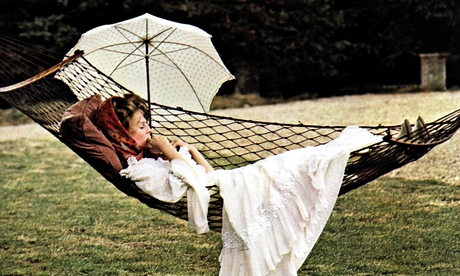
Summer literature doesn't stop with Sonnet 18, A Midsummer Night's Dream, Le Grand Meaulnes, Ulysses, The Great Gatsby and Whitsun Weddings. Here are a few more sun-drenched pages to mark this week's arrival of the season.
Alexander Pope, Summer – Second Pastoral (1735)
Source of the "where'er you walk" lines that Handel turned into the accompaniment for many a bride's entrance.
Emily Brontë, Moonlight, Summer Moonlight (1846)
Starts like a greetings card, ends like a crime novel's prologue.
Emily Dickinson, It will be Summer – Eventually (date unknown)
Keats, Shelley, Clare, Housman and Yeats all had a go, but the Amherst recluse may have written more summer poems than anyone else. This one manages at once to anticipate its arrival and treat it as already gone.
Ivan Turgenev, A Month in the Country (1855)
A landowner's bored wife flirts with guests in a play that inspired later "veranda" works – Chekhov's The Seagull and The Cherry Orchard and Gorky's Summerfolk.
Virginia Woolf, To the Lighthouse (1927)
Less obviously sunlit than Mrs Dalloway, but centring on the Ramsays' annual holidays on Skye.
LP Hartley, The Go-Between (1953)
Foreshadows Atonement in its protagonist – a child outsider observing adults' transgressive wooing – and its period setting (1900 for Hartley, 1930s for McEwan) and big house.
Patricia Highsmith, The Talented Mr Ripley (1955)
The eponymous conman attaches himself to playboy Dickie Greenleaf and his girlfriend, figures as glamorous as the sunkissed European resorts and cities that are the thriller's backdrop.
Françoise Sagan, Bonjour Tristesse (1954)
On holiday on the French Riviera with her philandering father, Cécile is put out when he installs a new mistress and schemes against her. Sagan was 18 when her debut became a huge hit, later providing the template for countless French movies with hints of incestuous father-daughter desires.
Ray Bradbury, Dandelion Wine (1957)
No sci-fi elements at all, just charming, loosely assembled memories of boyhood summers in the midwest, which became a trilogy. Something Wicked This Way Comes has the same setting, but the calendar and mood have advanced to Halloween.
John Updike, Couples (1968)
Updike's celebratedly raunchy novel unfolds between spring and autumn of 1962, following an on-heat set in Tarbox, Mass, who sleep with anyone but their spouses.
Lorrie Moore, Who Will Run the Frog Hospital? (1994)
The heroine looks back to a 1970s summer when she worked in a theme park – as, coincidentally, Stephen King later did in Joyland.
Ian McEwan, Atonement (2001)
Children and teens feature in many summer classics (eg To Kill A Mockingbird) and McEwan follows in that tradition in his tricksy tale of Briony Tallis, who spies on sister Cecilia and her lover. JD

